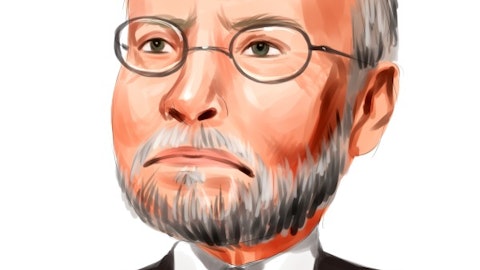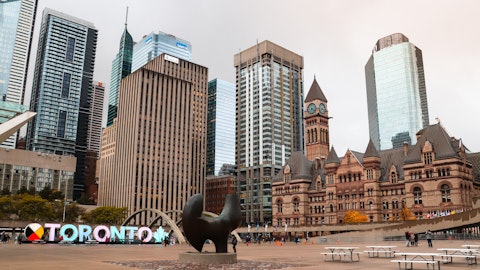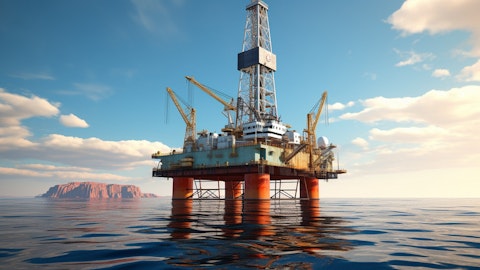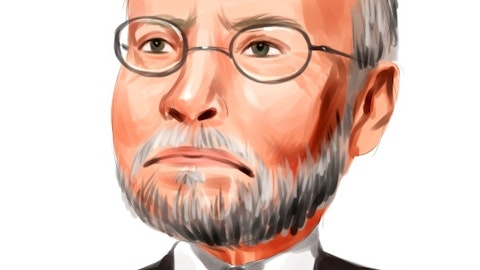Rich Kruger: So, Peter, comment on what’s different today about how we’re going about this than, say, maybe, a few years back before your time here on your perception of how the company was going about it. I’m really thinking about the – I’m looking at your little chart here, the tangible nature and the accountability by the component parts. So I’m giving you the cue on how to answer the question. You take it from there?
Peter Zebedee: There’s a very high degree of specificity in the tactics that we are taking to drive efficiency in the mine. I mentioned it earlier. This isn’t just something that we look at on a monthly basis in our performance stewardship. This is a day-by-day, shift-by-shift, dare I say, even by hour, hour-by-hour, driving efficiencies and improvements in our operation. That’s owned by the operating leaders at the sites. They understand what the targets are. They have a strong commitment to deliver and they understand what the big picture is and how that fits into, driving the overall corporate performance.
Rich Kruger: And going back to a comment I made earlier on is with a common organizational structure at all of our sites now, upstream and downstream, whether that’s a maintenance opportunity, an operational reliability, an engineering technical solution. We have natural networks now across the company who can collaborate on bringing, sharing ideas and bringing about in a faster way the execution of an idea companywide. And you might say, well, why weren’t you organized like that before? That’s a different question. But we are now. And I think that will help not only identify new opportunities, but accelerate their implementation.
Peter Zebedee: I think one of the clear things on when we reorganized through the back half of 2023 and really crystallized the accountabilities for a site. So that has enabled us to implement very efficient work processes, not just within a given site, but indeed across the breadth of the Suncor operating assets. So given role and my assets are very similar to, or exactly the same as what Dave has in the downstream and refining assets. Shelley’s central team is focused on delivering value to the assets. It’s a very asset centric organizational design, and it’s enabled by consistent work processes. So we are very clear on what’s required, who’s accountable to deliver it, and what a measure of success looks like. And that archetype is showing, to deliver some really good results for us, across our operations.
Menno Hulshof: Terrific. Thanks for that. That was a very thorough rundown. So maybe the second question for Rich. You’ve been in the seat for almost a year. So I have a question on your take on strategic fit for the four refineries. I think the fit is really obvious for Edmonton and Sarnia, but maybe a little bit more nuanced for Commerce City and Montreal. So the question is, how core do you consider Commerce City and Montreal? And if we look across the entire downstream portfolio, what are you seeing in terms of near-term opportunities to further enhance margin capture? Thanks.
Rich Kruger: Well, I think any of our assets, wherever they are, they’re about the value they can provide. And I would go a step further and say, is there something unique about our capabilities, our competencies? We’ve talked a lot about physical integration. Is there a unique level of value that we can bring to owning and operating an asset versus an alternative? Now, I mean, I think Commerce City is a bit more of an island compared to the rest of our operations, but it also has a strong market, and it’s got some logistical advantages there that we believe can add and create value. So the key for us over the last year and a half there, is keeping that thing up and running. And when it’s up and running, it generates a lot of cash.
I would say you look at the East Coast operations kind of in the same way. You’ve got the dichotomy of Hebron and Hibernia, non-operated, different kind of operations, and then you’ve got the two floaters. But again, it’s the idea of can we keep these assets up and running with high reliability, high integrity? And when we do, they can add material value to the enterprise. So we look at our assets individually, collectively, and it all comes down to what kind of value do, we believe they can. How well can we operate them and what kind of value can they provide to us?
Menno Hulshof: Thanks, Rich. I will turn it back.
Operator: Thank you. [Operator Instructions] And that will come from the line of Neil Mehta with Goldman Sachs. Your line is open.
Neil Mehta: Good morning, Rich and team. My first question is just around your framework for capital allocation. So that’s Slide 5. Maybe, Rich, you can step back and talk big picture about how, as you’re balancing the operational turnaround, you’re also prioritizing return of capital. And we’ve anchored to this $9 billion to $12 billion being the right net debt level, at which you shift to a 75% to 25% – versus 25% – 50%-50% payout. But how are you tracking towards that? Are those the right levels as you spent more time thinking about it?
Rich Kruger: Yes, Neil, I’m going to ask Kris to comment here in a second, but I want to step back again and frame it in the context of why we keep talking about this $5 a barrel. Our breakeven now is kind of 50-ish or low 50s, and we want to take $5 out of that so that we have a greater level of financial resiliency and the inevitable ups and downs of this business that we’re in. And so in doing that, that allows us, from a capital allocation standpoint, to weather the storms when we get in weak market conditions, and be more opportunistic when maybe others are in a bit more of a difficult position. So the $5 a barrel objective we have aligns with then having a – ensuring we have a strong balance sheet, we have financial resiliency.
We can pay all of our bills in good times and bad. I put dividend in those bills. And then have the added flexibility of continuing to return cash to shareholders. But Kris, you maybe want to talk more specifically about the current structure we have and our thoughts?
Kris Smith: Yes, I mean, as you pointed out, our capital allocation structure is pretty clear. When we hit $12 billion net debt, we go to 75, 25 buyback and reduction. And then once we get to $9 billion, and that is a net debt basis, including capitalized leases. We’re focused on that framework. I think to piggyback on Rich’s comments, what we’re trying to do is drive more free cash flow out of the business so we can drive to those targets even more quickly. Now, obviously, it’s all going to be dependent on where commodity price lands, and people will take varying views of when we’re going to hit the $12 billion. But we’re focused on driving that debt down while continuing to return cash to shareholders. I mean, I think to your other question about will the targets change?
I mean, we’re always looking at the resiliency of the business, and do these targets make sense. But in a commodity business like this, as you know, having really strong balance sheet. And we want a balance sheet in a place that’s going to weather, not even mid-cycle low, below mid-cycle pricing. And that’s really what the $9 billion is driving towards. But we’re continually looking at our capital position. We’re driving, but the allocation framework isn’t changing at this time.
Neil Mehta: Thanks, Kris. And then the follow-up is just on Slide 13. It is a pretty heavy year for economic investment capital between West White Rose, the well pads, Mildred Lake, the Drum, Cogen, and Fort Hills and the trucks. So maybe you could just talk about that set of projects, how they’re tracking relative to expectations and update on the investments that you’re making here?
Rich Kruger: I think, on West White Rose, I’ll let the operator maybe comment a bit more on that. But I think, you know, we do have a lot of things going on. The Coke Boiler Replacements will be wrapping up later this year as we approach start-up. Well pads are quite economic investment for us. And so, we’re wrapping some things up. And now we’re really looking at kind of what goes on from here forward in terms of what is the right level of CapEx. But, maybe if there’s any – in terms of the execution, Shelley, you want to comment a little bit on the capital projects and/or Peter, the bulk of the monies in you guys’ areas. Any comments you’d offer there?
Shelley Powell: Yes, I think you’ve hit the high points. The execution for all of those major projects is on track, proceeding as we expect them to be. Some of the – certainly the Coke Boiler Replacements, we’re into system turnover, starting to commission some of those key systems. So we’re expecting that spend to progress as we expected it to be.
Rich Kruger: One of the things I’d comment on projects. Projects is just like operations and others. It’s a specialty expertise that goes with planning and executing projects. You know, shame on us. We learned a lot through Terra Nova. But as we’ve been learning it, we’ve been strengthening our execution capability in other areas. And although turnarounds are different, they also have a lot of similarities in the importance of pre-planning, ensuring you have the necessary resources, scheduled out in time. So this is a whole area of emphasis for us on planning and executing our work. And that applies really across the board, but you’ll really see it tangibly in project execution.
Neil Mehta: Thank you, Rich.
Operator: Thank you. [Operator Instructions] And that will come from the line of Patrick O’Rourke with ATB Capital Markets.
Patrick O’Rourke: Hey, guys. Good morning. And congratulations on a strong quarter. Thanks for taking my questions here. You spent a lot of time going over sort of mining operations, but you touched on in situ opportunities earlier in the call. I’m sure a lot out there, just like myself, have been watching very impressive results at Firebag & MacKay. And you’re running, from what I can see, very close to nameplate capacity there. So I’m just wondering if you could kind of maybe unpack a little bit more what the opportunities in the thermal units are. Are they growth? Are they capital efficiency? Are they on the operating cost side and what that could look like going forward?
Rich Kruger: Sure. If you look back over our last 10 years, we had such intense focus on mining with the initial investment at Fort Hills and things. And it’s not – I’m going to use a word, and I don’t mean it quite as strong, but in a sense, our in situ kind of took a bit of a backseat in some regards, because we had so many other capital needs. But as we look at the quality of that operation, Firebag’s a rock star. I wish we had a couple more of them. And we do have opportunities to continue to de-bottleneck at lower relative, cost per flowing barrel at Firebag. We’ve got opportunities for new developments, Lewis or Firebag South. And what we’re doing right now, and this gets in kind of to the Investor Day, we’re doing a lot of work right now to answer some key questions there about what’s next, what’s the most capital efficient and when.
And I’d love to have those questions earlier rather than later, but it’s going to take us, the bulk of the spring and the summer to get there on some of those. But I think in situ plays into our future in a bigger way, so that your question is a good setup. You’re going to hear more from us about in situ. Some of the opportunities are very much low cost de-bottlenecking at the Firebag plant in itself, water handling capability, whatnot. Where you can spend a small amount of money and open up, 2,000, 3,000, 4,000, 5,000 barrels a day of additional capacity. We’re also testing solvent technologies. Solvent to me is a winning formula. If you can convince yourself you get equal to, or better recovery, you lower carbon emissions with it, lower steam use.
So we’ve got some pilot work that’s, some of it that’s wrapping up this spring. And so you can expect to hear more on that. But in the Greenfield developments, we’re also, like Lewis, for example, we’re looking at synergies given its proximity to the Base Plant with surplus steam utilization. So here again, it comes back to the concentrated, geographic footprint of our assets, the physical integration of what we have, and the ability to do things, or add value that are above and beyond what our competitors can say. So, you answered, or you asked a great question for me, because in situ is something you’re going to be hearing more and more from us about in the, in the months and the quarters ahead.
Patrick O’Rourke: Okay, great. Thank you. And just to follow-up here, just looking ahead at the year, I know, a lot of these risks are completely unpredictable. We have had things like wildfires in the past, but one of the things we have been watching is, drought conditions here, Athabasca River, water levels and flow rates look okay so far, but just wondering if you have any contingencies, or any concerns on that end?
Rich Kruger: Yes. I am going to ask Peter to comment on that specifically, because obviously the importance of water to our resource. And of course, our operations are where the vast majority of the source of water is in Alberta. And we in industry use a relatively small fraction of that source. But Peter, you want to comment a little bit about kind of our overall approach around water use and management?
Peter Zebedee: Yes, absolutely, Rich. I think I would like to start by just saying, in our operations today, we are recycling 94% of the water we use in our operations, and we are very careful in the amount of water that we are drying off the river. We are – we have contingency plans in place, yes, absolutely. And we are also casting our eyes to the future to look at investments that will reduce our water intensity across our operations. First and foremost, at Base Plant, we will look to develop a potential waste water treatment plant, and bring that kind of by the – towards the end of the decade here. So, first, in our operations, it is all about efficiency and scarcity of use, heavy focus on recycling and building the contingency, and so that we can weather through these drought conditions that we are going to see across the province this summer.
Patrick O’Rourke: Okay. Thank you very much.
Operator: Thank you. [Operator Instructions] And that will come from the line of Manav Gupta with UBS. Your line is open.
Manav Gupta: Well, my first question here is, it looks like you don’t have too much downtime in the refining segment in 1Q. Your fourth quarter of capture number was 103%. Every time the capture goes over 100%, we view that very favorably. Looks like a lot of North America is in a turnaround and you are running all out in 1Q. Does that set you up very well for at least the first half of the year as far as downstream earnings are concerned?
Rich Kruger: Yes. I think we like the 100% too. That’s good, right, Dave?
Dave Oldreive: Sure is.
Rich Kruger: We like more than 100%. Yes, I will ask Dave to comment. We do have turnarounds at Montreal and Sarnia that come on this year in the kind of second quarter-ish. But you are right, for the rest of the bulk of the first quarter, we are going to be up and running. But Dave, comment on that. But I also want, I have asked you to give your quarter a pint of blood on the $5 a barrel. So, answer that question, but then also talk about what the downstream is doing to contribute to our $5 a barrel corporate breakeven reduction. So, Manav, sorry, you still get another question. But I want Dave to comment on what his team is doing in that regard as well.
Dave Oldreive: Sure. Thanks Rich and thanks Manav for the question. Well, that’s actually a lot of material to go work with. I could probably spend a bit of time on this one. But you mentioned margin capture, and I think the story for the first quarter is going to be fairly similar to the story for the fourth quarter. And for the fourth quarter, we delivered, a strong margin capture. And when I think about it we – Kris mentioned some of the reasons why we were able to run our refineries full, why they are economic, and we have got some structural advantages in terms of our G2D, our location, our connectivity to upstream, as well as our retail business. But we ran full and saw a strong margin capture. I would also flip that around.
Running full allows you to capture strong margin capture. Strong margin capture gives you the economics to run full, and we saw both. In the downstream, in the fourth quarter, we have optimization that our downstream teams do aggressively every day, and we saw some really good examples of that. First off, reliable operations allowed us to optimize our molecules through our refineries and integrate the value chain to the customer. We were also able to give economic full signals to all of our refineries despite falling gasoline prices. That was assisted by, deeper West Can crude discounts, particularly on SCO, our lower G2D ratios relative to our competition, and our ability to export diesel across both coasts, and that – it will continue through the first quarter as well.
That ability to move diesel across both coasts and ability to move volume between the two regions East to West on rail is a real good advantage for us to allow us to take advantage of that. Our Edmonton Refinery is highly integrated with our upstream assets, and we optimize that every day to make sure that we fill out the refinery to all of its constraints, as well as try to tailor to meet our customer demands, and that’s a unique capability in the industry. Our trading organization has done a great job in the fourth quarter, continues in the first quarter, to move volumes off the coast at really good netbacks. We saw that in December. We see that through January while gasoline cracks were low. Gasoline cracks have picked up. That should continue to help us.
And our rack forward business was – just continues to be strong and provides a nice cushion. It also provides a little bit of a cushion in the following pricing market, which we saw through the fourth quarter in our wholesale pricing when our street price kind of lagged wholesale pricing and so really good fourth quarter in terms of margin capture. We would expect that to continue through the first quarter. In terms of value capture, that’s a really exciting thing for us in the downstream. If we think about, where are our opportunities – Peter talks a lot about how we reduce costs of mining, that’s the big opportunity in the upstream. In the downstream, our volumes are a little bit smaller. And the cost of production is – it’s a smaller piece to work with to begin with.





